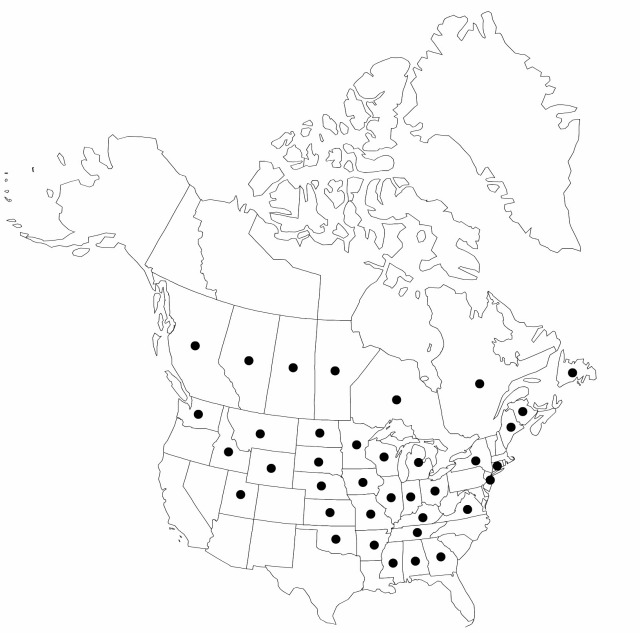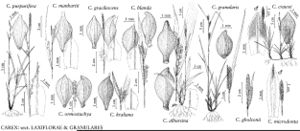Carex crawei
Amer. J. Sci. Arts, ser. 2, 2: 246. 1846.
Rhizomes long-creeping. Culms solitary (rarely 2 together), 2–30(–40) cm. Leaves light green, cauline blades tending to be recurved, 0.6–9.7 cm × 1.5–4.4 mm; widest leaves 1.8–3(–4.4) mm wide. Inflorescences: peduncle of terminal spike (0.4–)0.9–7.6(–9.1) cm; bracts usually shorter than culms; ligule of proximal bract 0.1–2.2 mm; longest bract blade (per plant) of distal lateral spike 2–6.7 cm. Proximal spikes usually arising from proximal 1/2 of culms, 5–27 × 3.1–6.3 mm. Terminal spike (5–)11–24 mm, usually separated from distal lateral spike (unless staminate). Pistillate scales ovate or ovate-triangular, 1.2–2.9 × 1.1–1.6 mm. Staminate scales with apex rounded to obtuse. Anthers 1.9–2.9 mm. Perigynia yellowish green to pale brown, oblong-ovoid to ellipsoid, 2.2–3.4(–3.7) × 1.1–1.9 mm, 1.4–2.6 times as long as thick; beak 0.1–0.3 mm, orifice entire or nearly so (teeth to 0.1 mm). Achenes 1.4–1.9 × 1–1.8 mm, not including prominent apiculus 0.2–0.4 mm. 2n = 38, 59, 60.
Phenology: Fruiting late spring–late summer (May–mid Aug).
Habitat: Dry to usually moist, open ground, often associated with calcareous gravels or limestone pavements, in wet meadows, fens, prairie swales, beach pools, shores and glades, less commonly edges of white-cedar thickets, prairie patches along rights-of-way, streams, ditches, and quarries
Elevation: 0–2700 m
Distribution

Alta., B.C., Man., N.B., Nfld. and Labr. (Nfld.), Ont., Que., Sask., Ala., Ark., Conn., Ga., Idaho, Ill., Ind., Iowa, Kans., Ky., Maine, Mich., Minn., Miss., Mo., Mont., Nebr., N.J., N.Y., N.Dak., Ohio, Okla., S.Dak., Tenn., Utah, Va., Wash., Wis., Wyo.
Discussion
Though widespread, Carex crawei is usually rare or local except near the shores of the Great Lakes, glades in the Interior Highlands, and prairie swales on parts of the Great Plains. Other authors have reported it from Nova Scotia (H. J. Scoggan 1978–1979, part 2; earlier mentioned by M. L. Fernald 1948 on the authority of J. M. Macoun 1899); no specimens to substantiate the reports have been found.
The perigynia in Carex crawei are usually smaller than in C. microdonta. A few specimens from Ontario and New York with all other characteristics of C. crawei have larger and slightly beaked perigynia that approach those of C. microdonta.
Selected References
None.
